AMD Announces Ryzen 5 Lineup: Hex-Core from $219, Available April 11th
by Ian Cutress on March 15, 2017 10:00 PM EST_678x452.jpg)
As part of our initial Ryzen 7 review, AMD also teased the presence of two more elements to the Ryzen lineup, specifically Ryzen 5 and Ryzen 3, both aiming at a lower cost market and allowing AMD to sell some of the silicon that didn’t quite make it to the Ryzen 7 lineup. Today is the official announcement for Ryzen 5, featuring four processors in hex-core and quad-core formats, all with Simultaneous Multi-Threading (SMT) and all using the same AM4 platform as Ryzen 5.
Ryzen 5
Whereas Ryzen 7 was AMD’s main attack on high-performance x86 and a shot across the bow against Intel’s high-end desktop platform, Ryzen 5 is targeted more at mainstream users. The goal here is that where Intel has four cores with no hyperthreading, AMD can provide six cores with SMT, effectively offering three times as many threads for the same price and potentially smashing any multithreaded workload.
Without further ado, here is where the Ryzen families stand:
| AMD Ryzen 7 SKUs | |||||||
| Cores/ Threads |
Base/ Turbo |
XFR | L3 | TDP | Cost | Cooler | |
| Ryzen 7 1800X | 8/16 | 3.6/4.0 | +100 | 16 MB | 95 W | $499 | - |
| Ryzen 7 1700X | 8/16 | 3.4/3.8 | +100 | 16 MB | 95 W | $399 | - |
| Ryzen 7 1700 | 8/16 | 3.0/3.7 | +50 | 16 MB | 65 W | $329 | Spire RGB |
| AMD Ryzen 5 SKUs | |||||||
| Cores/ Threads |
Base/ Turbo |
XFR | L3 | TDP | Cost | Cooler | |
| Ryzen 5 1600X | 6/12 | 3.6/4.0 | +100 | 16 MB | 95 W | $249 | - |
| Ryzen 5 1600 | 6/12 | 3.2/3.6 | +100 | 16 MB | 65 W | $219 | Spire |
| Ryzen 5 1500X | 4/8 | 3.5/3.7 | +200 | 16 MB | 65 W | $189 | Spire |
| Ryzen 5 1400 | 4/8 | 3.2/3.4 | +50 | 8 MB | 65 W | $169 | Stealth |
Traditionally we are used to a part with fewer cores having a higher clock frequency, however perhaps due to the voltage scaling of the design, we see a matched Ryzen 5 1600X in frequency to the Ryzen 7 1800X, but the rest of the Ryzen 5 family are offered at a lower TDP instead.
All the Ryzen 5 parts are unlocked, similar to the Ryzen 7 parts, and all four exhibit some movement in XFR mode, with the 1500X offering +200 MHz depending on the cooler used. AMD is going to offer some of these SKUs with their redesigned Wraith coolers:
It is worth noting that the Wraith Spire for Ryzen 5 will not have RGB lighting, whereas the Wraith Spire for Ryzen 7 does use an RGB ring. OEMs will be able to use the higher-end Wraith Max stock cooler for their pre-built systems. AMD stated that at present, there are no plans to bring the Wraith coolers to retail as individual units, however they will keep track of how many users want them as individual items and regularly approach the issue internally.
To clarify some initial confusion, AMD has given me official TDP support numbers for the coolers. The entry level Wraith Stealth is 65W, the Wraith Spire is 65W for high-ambient conditions (AMD states this might be considered an '80W' design in low-ambient), and the Wraith Max is 95W for OEM builds using Ryzen 7 95W parts.
All the Ryzen 5 parts will support DDR4 ECC and non-ECC memory, and the memory support is the same as Ryzen 7, and will depend on how many modules and the types of modules being used. Recently companies like ADATA announced official support for AM4, as some users have found that there were memory growing pains when Ryzen 7 was launched.
Platform support for Ryzen 5, relating to PCIe lanes and chipset configurations, is identical to Ryzen 7. Each CPU offers sixteen PCIe 3.0 lanes for graphics, along with four lanes for a chipset and four lanes for storage. Chipsets can then offer up to eight PCIe 2.0 lanes which can be bifurcated up to x4 (AMD GPUs can use chipset lanes for graphics as well, however at reduced bandwidth and additional latency).
Competition
The high-end Ryzen 5 1600X, at $249, is a shoe-in to compete against Intel’s i5-7600K at $242. Intel’s CPU is based on the Kaby Lake microarchitecture, and we’ve already shown in the Ryzen 7 review that by comparison Ryzen is more circa Broadwell, which is two generations behind. AMD won’t win much when it comes to single-threaded tests here, but the multi-threaded situation is where AMD shines.
| Comparison: Ryzen 5 1600X vs Core i5-7600K | ||
| AMD Ryzen 5 1600X |
Features | Intel Core i5-7600K |
| 6 / 12 | Cores/Threads | 4 / 4 |
| 3.6 / 4.0 GHz | Base/Turbo | 3.8 / 4.2 GHz |
| 16 | PCIe 3.0 Lanes | 16 |
| 16 MB | L3 Cache | 6 MB |
| 95 W | TDP | 91 W |
| $249 | Price (MSRP) | $242 |
Here we have twelve threads against four, at a 95W TDP compared to a 91W TDP (the 1600 is 65W, which looks better on paper). It is expected that for situations where a compute workload can scale across cores and threads that the AMD chip will wipe the floor with the competition. For more generic office workloads, it will interesting to see where the marks fall.
On the quad-core parts, there are several competitive points to choose from. The AMD Ryzen 5 1500X, at $189, sits near Intel’s Core i5-7500 at $192. This would be a shootout of a base quad-core versus a quad-core with hyperthreading.
| Comparison: Ryzen 5 1500X vs Core i5-7500 | ||
| AMD Ryzen 5 1500X |
Features | Intel Core i5-7500 |
| 4 / 8 | Cores/Threads | 4 / 4 |
| 3.5 / 3.7 GHz | Base/Turbo | 3.4 / 3.8 GHz |
| 16 | PCIe 3.0 Lanes | 16 |
| 16 MB | L3 Cache | 6 MB |
| 65 W | TDP | 65 W |
| $189 | Price (MSRP) | $182 |
The reason why I didn’t pull out the Core i3-7350K there, at $168, is because the performance of the 7350K sits near the Pentium G4560, which is only $64 (and the subject of an upcoming review). That all being said, the $168 price of the i3-7350K matches up to the $169 price of the Ryzen 5 1400, although the 1400 has double the cores and double the threads of the 7350K.
Cutting up the Cores
Ryzen 5, both the hex-core and the quad-core variants, will use the same eight-core base Zeppelin silicon that Ryzen 7 does.
The silicon design consists of two core complexes (CCX) of four cores apiece, and each with 8MB of L3 cache that is an exclusive victim cache. One of the suggestions regarding Ryzen 7’s performance was about thread migration and scheduling on the core design, especially as core-to-core latency varies depending on where the cores are located (and there’s a jump between CCXes). Despite the use of AMD’s new Infinity Fabric, which is ultimately a superset of HyperTransport, there is still a slightly longer delay jumping over that CCX boundary, although the default Windows scheduler knows how to manage that boundary as demonstrated by Allyn at PCPerspective earlier this week.
So when dealing with a four-core or six-core CPU, and the base core design has eight-cores, how does AMD cut them up? It is possible for AMD to offer a 4+0, 3+1 or 2+2 design for its quad-core parts, or 4+2 and 3+3 variants for its hexacore parts, similar to the way that Intel cuts up its integrated graphics for GT1 variants. The downside with this way is that performance might differ between the variants, making it difficult to manage. The upside is that more CPUs with defects can be used.
We have confirmation from AMD that there are no silly games going to be played with Ryzen 5. The six-core parts will be a strict 3+3 combination, while the four-core parts will use 2+2. This will be true across all CPUs, ensuring a consistent performance throughout.
Performance Estimates
We won’t have these CPUs in for a while, but given our new benchmark suite and the results we’ve seen so far with Ryzen, we’ve tried to lay out some estimates in performance in both single thread and multi-threaded workloads.
Single thread performance is easy enough to estimate – we work from the turbo and XFR frequencies of each processor. For users looking for peak single thread performance, something like Intel’s Pentium G3258 or i3-7350K that can be overclocked to 5GHz+ (or starts as a base 4.2 GHz) is going to be a performance per dollar crown here. On the AMD side, we expect the Ryzen 5 1600X to match the Ryzen 7 1700X as it has the same frequency.
Multithreaded is more difficult to predict. Some of our benchmarks offer perfect scaling across cores and threads, meaning that if you half the cores, you get half the score. Some of the benchmarks are not as clear cut though, hence why we see something like Intel’s Core i3-7350K, which should get about half the score of an i7-7700K, scoring 65% instead of 50%. We’ve tried to take this into account with the Ryzen 5 parts, and we get the graph above.
The key results here show that the 1600 and 1600X should sit way above the i5-7600K, and the 1600X should offer so much better performance per dollar than the Core i7-7700K.
On overall performance, taking the combination of results (our suite is slightly unbalanced in favor of MT, but this is taken into consideration) we funnily see a straight line between the 1800X, 1700X, 1700, 1600 and 1500X, putting the 1600X at a really good position as a performance per dollar CPU.
The caveat here is that the Ryzen 7 processors came across as good workstation processors. Ryzen 7 was marketed towards that group of users, and it made sense. Ryzen 5 is more targeted towards mainstream gamers and users, which might offer some interesting results. Our results don’t feature any gaming numbers yet (still working on a Ryzen 7 part 2 for this), but it will be interesting to see how the core counts and frequency will affect gaming performance.
The Bottom Line
Ryzen 5.
Two CPUs with six-core, from $219-$249.
Two CPUs with four-core. From $169-$189.
Retail availability on April 11th.
Stay tuned for the AnandTech review.
(Ryzen 3 is still slated for 2H17.)


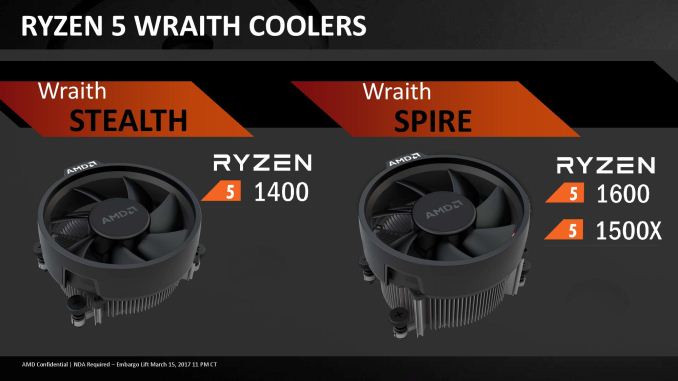
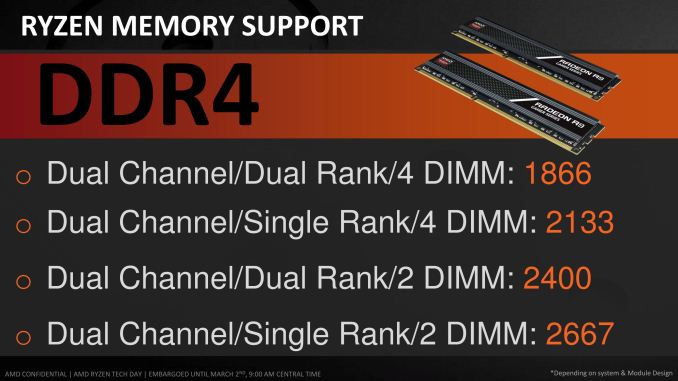
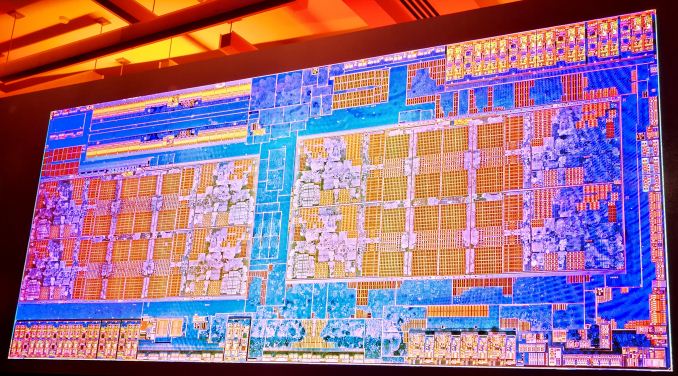
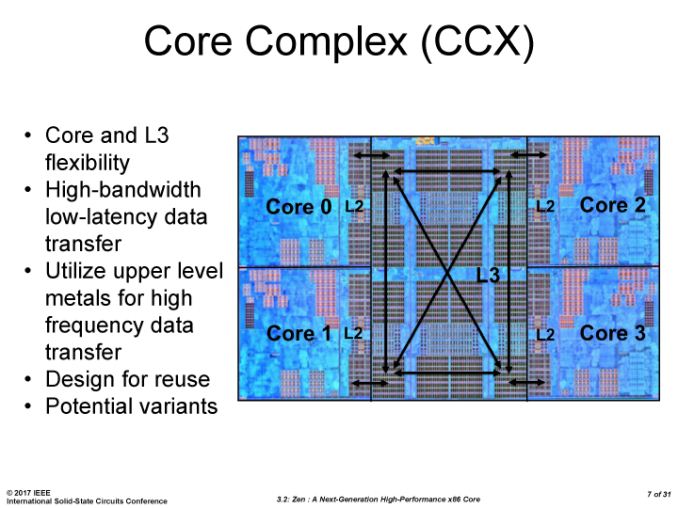
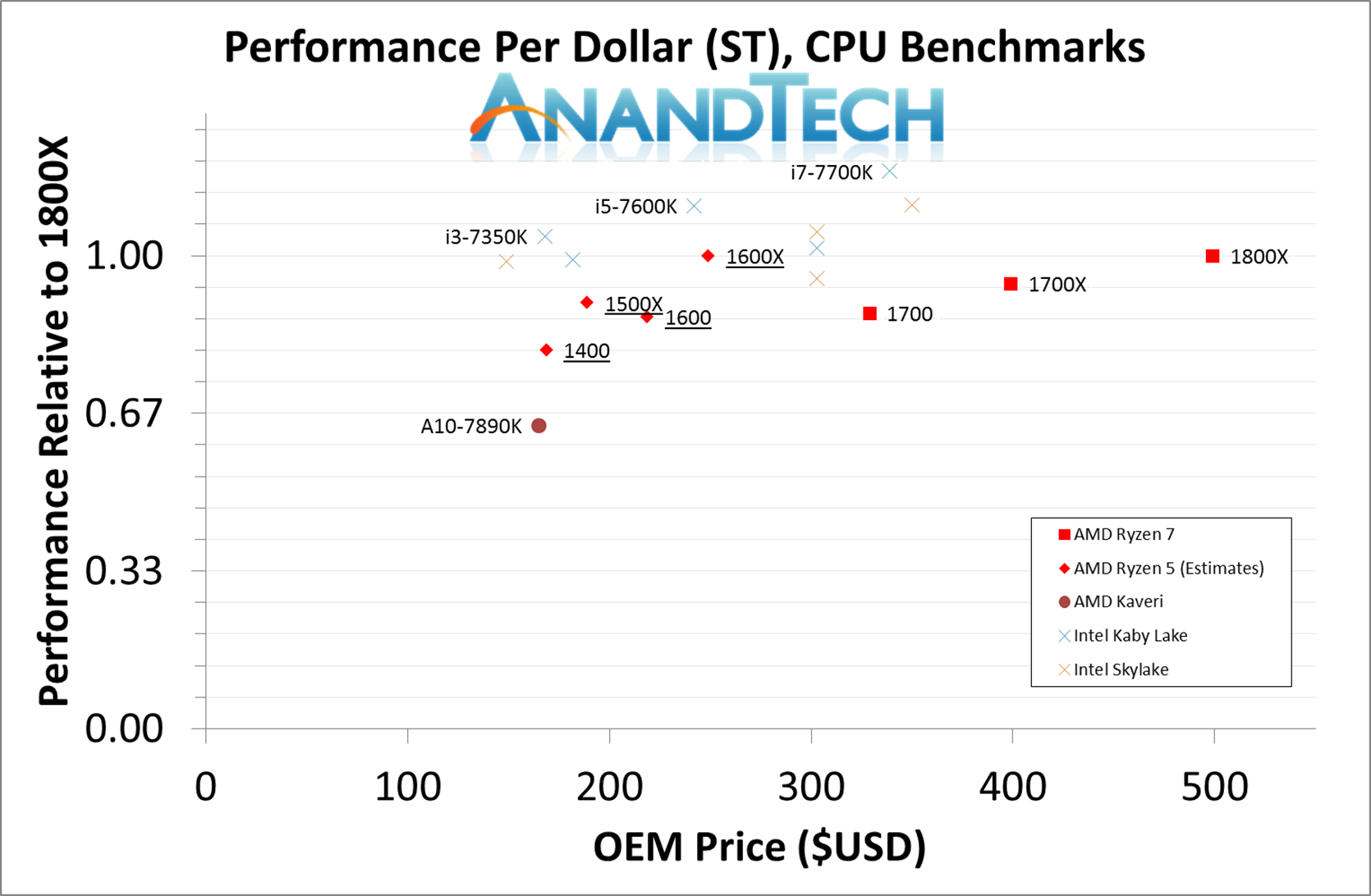


_thumb.jpg)
_thumb.jpg)
_thumb.jpg)
_thumb.jpg)
_thumb.jpg)
_thumb.jpg)








229 Comments
View All Comments
redrobin9211 - Thursday, March 30, 2017 - link
Looks like you never played Counter Strike. Frames matter a lot in FPS games specially games like CS.Haawser - Thursday, March 16, 2017 - link
Ok, let me ask you a question; Which of these rigs would be faster-$219 R5 1600 + $390 GTX 1070 (Total $609) Or.. $339 i7-7700K + $250 GTX 1060 (Total 589)
Take into account the difference in motherboard cost and they cost ~the same. So if you had a budget of ~$600 for a new CPU and graphics card, which one should you buy ? As a gamer ?
goldstone77 - Saturday, March 18, 2017 - link
It also depends mostly on the resolution you are using. Anything higher than 1080p then the CPU doesn't matter and AMD could easily be a better choice if you are looking for better productivity. At 1080p we won't know until benchmarks come out on the R5's. If they are anything like the R7 line the will not be capable of high FPS like Intel processors, but may still be capable of high enough FPS that it will be fine and still a big improvement on productivity vs. intel. Also, new games that use api like Vulkan in games like DOOM the FPS is so high it doesn't matter which processor you use! So, AMD would be a good pick-up for the extra productivity!HomeworldFound - Thursday, March 16, 2017 - link
It works pretty well from a multi-tasking perspective and gives games like WatchDogs 2 additional stability instead of varied performance.theuglyman0war - Monday, March 20, 2017 - link
I'll definitely stay with Intel if they address the competition with a 6 core canon-lake ( which I believe is the case? ) i7-8700k ( or 9700k if 8th gen is coffee lake ) If they are priced well under $300.Otherwise 4 cores or way better than 2 for the same reason 6 WILL be better than 4 soon! Direct X12 is going to leverage as much to offload more power to the GPU. And 1080p is only a thing till the fidelity of 4k is fast. I can barely stand to look at 1080p anymore! ( amazing how the brain iz wired not to favor perceived loss of quality! )
But when someone hands me a phone with a 1080p screen I instantly notice and find as much revoltingly primitive now that my brains is wired for the crisp sharp legibility of a phone gui with a QHD AMOLED screen's fidelity and jet black inky self emitting diode yummyness.
We are at an awful place of high prices on this display tech. When I consider all my monitors temp solutions. Speed is great. But I am really looking forward to rec2020 combined with Samsung's upcoming QLED self emitting variant ( or OLED ).
In which case..
Speed is not everything for gamers. particularly when the best talent producing graphics still have to compromise on their render targets making the best graphics even look butt ugly sadly.
If Speed was everything no one would be asking if it can run Crysis. We would all be playing CS with the graphics set to "butt ugly". pew pew pew.
Kind of sucks that all this color accuracy, fidelity and contrast ratio is all CURRENT TECH. But I know of no gaming monitor that have a combination of all 3 yet?!!! I easily feel like I am being milked! Speed apparently isn't a thing in TV land ( though consoles still claim there is no thing as PC master race.) But it doesn't matter anyway because the 32" TV market that once ruled! Isn't providing an alternative offering 4k HDR10 WCG OLED 32" TVs...
Which would at least make do till the gamer branded bait monitors sold as much for $2000! :(
Last thing I am worried about is the future of 1080p bangity bangity bangity fps. ( we all can't be the top 5 percent e-sport top dogs )
Hardly representative of anything but a niche concern ( though a valid one! 1080pew pew )
But as someone looking forward to these CPUs IMPROVING the landscape with competition for US INTEL FANS! Sort scratching my head to at some of the negativity thats flying at such a niche concern!
This is going to be the best thing that ever happened to Intel?!!
Sounds like some are trying to sabotage efforts to light a flame under their sleepwalking a55es when we all know they have been cruizen incrementally at an arrogant premium!
Friends don't let friends cruize at arrogant speeds.
Ro_Ja - Thursday, March 16, 2017 - link
"When was the last time you heard someone bragging about a igpu?"My friend actually does, lol. I kinda of agree with my friend though I'm not too convinced that (example) an Iris Pro 580 from some high end Intel chip is better than a GT 750M.
vladx - Thursday, March 16, 2017 - link
In fact they're about equal, GT 750M is only a bit better in Nvidia-optimized games.0ldman79 - Saturday, March 25, 2017 - link
I've got a 960M and an Intel 530.All of the Arkham games aside from Knight can play with the 530 @ 720p at 60fps. Knight won't even load with the 530... lol
Just tinkering to see what they would do. With my default 960M @ 60fps settings the 530 only produces 6fps.
redteam6 - Friday, March 24, 2017 - link
first you dont have to go intel for 1080p. when you and pust over 150 fps with a gtx 1080whats the point if your processor has 5% ipc. If you stream on a i7 there goes your lead.
second 5 to 10 percent is hardly brag worthy. Especially when they had to over clock the i7 to 5ghz to do it. I would rather have 8 more threads then 5 percent better ipc any day. ryzen processors are beast at low prices. With the 1600 at 219usd why in the hell would you ever consider and i7 quad core. period. Done end of fn story.
Morawka - Wednesday, March 15, 2017 - link
not just IPC, Ryzen simply can't clock high.. 4Ghz is considered the top end of overclocking for Ryzen. The new Kabylakes hit 5ghz on air, easily.Until more games multi-thread, the gamers choice of intel is justified. now the for the creative or video editor, ryzen is a steal.